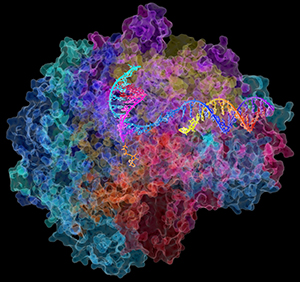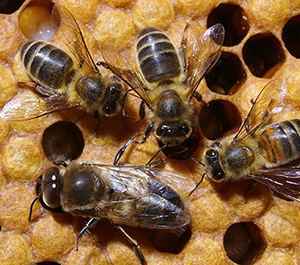Instructor Insights
Below, Dr. Diviya Ray describes various aspects of how she and Prof. Hazel Sive taught Pre-7.01 Getting up to Speed in Biology.

An RNA polymerase molecule catalyzing the transcription of DNA. (Image by David Bushnell, Ken Westover and Roger Kornberg, Stanford University, courtesy of NIH Image Gallery on Flickr. License: CC BY-NC.)
OCW: What was your team’s motivation for creating Pre-7.01?
Dr. Diviya Ray: Our broad goal for creating Pre-7.01 was to improve the preparation of MIT students, specifically those with insufficient academic preparation for the general institute requirement (GIR) in biology (7.01). We accomplished this goal by the following means:
- Designing a new, short (2.5 week) course and offering it during the 2016 Independent Activities Period (IAP) to students who felt that they had an insufficient background in biology to succeed at the Introductory Biology GIR.
- Covering material that encompasses the essential topics, specifically elements of cell biology, biochemistry, genetics, and molecular biology, that are taught across all the 5 different versions of the Biology GIR (7.012/ 7.013/ 7.014/ 7.015/ 7.016) and 7.00x.
- Introducing the students to problem-solving approaches embedded in the MIT biology curriculum.
- Providing extensive feedback to the students, one-on-one or in small groups both during lectures, in-class discussions, and open office hours, and also via email in response to their submitted assignments and exams.
- Carefully monitoring each student’s progress and being in constant touch with them through both Pre-7.01 and the 7.01 courses into which they eventually enrolled.
- Receiving constant feedback from the students to further improve Pre-7.01 during its subsequent iterations.
- Using scaffolded exercises to help the students master skills.

Female honeybees, like the three worker bees at the top of the image here, are diploid and have 32 chromosomes; male bees, like the drone in the lower part of the image, are haploid, having only 16 chromosomes. (Photo courtesy of Max Westby on Flickr. License: CC BY-NC-SA.)
OCW: In what form was pre-7.01 used on the MIT campus? What impact, in your view, did pre-7.01 have on students’ success or engagement with biology at MIT?
Dr. Ray: Pre-7.01 was initially offered as an on-campus course during IAP 2016 and IAP 2017. During this time, we built the online version of the course on the MITx platform, which included lecture videos, scaffolded exercises, problem sets, and one exam. In this format, the course was offered as an online self-paced course from 2018 to 2020 for any student who needed a refresher in biology before enrolling into 7.01 courses.
Students’ responses to Pre-7.01 have been overwhelmingly positive. We are excited to report that ALL the students who enrolled in and attended the initial iteration of Pre-7.01 successfully completed this course.
Furthermore, after completing Pre-7.01, the students who enrolled in 7.013 or 7.014 during Spring 2016 successfully completed their biology GIR. Based on these preliminary data and student evaluations, we believe that Pre-7.01 helped the students build their confidence in biology and optimized their chances of completing the biology GIR with more enthusiasm.
Many current and former 7.01 students later told us via email or in person that they would have benefited by taking Pre-7.01 had they known about this new course. This suggests that we should robustly advertise this course and its offerings in the future to reach out to more students.
› Read More/Read Less
OCW: What instructional strategies that were key in this learning experience?
Dr. Ray: In Pre-7.01, instead of regular recitations, we experimented with scaffolded exercises during recitations. Here, we provided temporary support to the students that would help them apply the concepts they learned while problem-solving. Like physical scaffolding, the supportive strategies were incrementally removed when they were no longer needed. We were able to monitor the students’ progress, address their misconceptions, and provide real-time feedback using the online tool Formative. The students really enjoyed this approach and learned a lot.

Melanism in jaguars (left) is caused by a dominant allele; melanism in leopards (right) is caused by a recessive allele.
(Jaguar photo courtesy of Peter Hopper on Flickr. License: CC BY-NC. Leopard photo courtesy of John on Flickr. License: CC BY-NC-SA.)
Like in MIT’s introductory biology courses, we gave an on-paper exam at the end of the course. However, instead of giving students a time limit of 50 minutes, we asked them to complete the exam at their own pace. We were surprised to see that although most students did complete the exam within 50 minutes, they did better when they realized there was no time constraint. Based on these results, we modified our exam strategy for 7.013 and offered 1.5 hours for a regular 50-minute exam to take the time pressure issue away from the students, so that they could better show what they had learned. This really worked in 7.013 too and was much appreciated by the students.
OCW: How could your experiences in creating Pre-7.01 be helpful to instructors who teach other courses?
"Designing a course, especially one with scaffolded exercises, takes time. But the students truly appreciate it."
Dr. Ray: Students taking other GIR courses very likely experience the same challenges as those in the biology GIR. Having a refresher for each GIR would tremendously help the students start their courses with more confidence and would help them get more from the course overall. Designing a course, especially one with scaffolded exercises, takes time. But the students truly appreciate it. So I would strongly recommend designing a refresher course for each GIR.

This zebrafish’s DNA contains two artificially inserted genes that cause the cells of its blood vessels to luminesce red
and its lymphatic vessels to luminesce green. (Photo by B. Weinstein, National Institute of Child Health and Human
Development, National Institutes of Health, courtesy of NIH Image Gallery on Flickr. License: CC BY-NC.)
Curriculum Information
Prerequisites
None
Requirements Satisfied
None
Offered
Pre-7.01 is offered as a self-paced, online, noncredit course in the summer and Independent Activities Period (IAP).
Student Information
Breakdown by Year
Primarily first-year students
Typical Student Background
Most students taking Pre-7.01 are first-year students who studied biology in high school but want a refresher before enrolling in their first college-level biology class.










